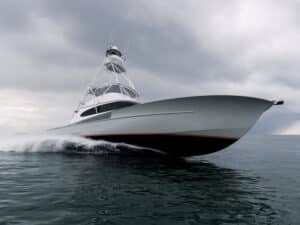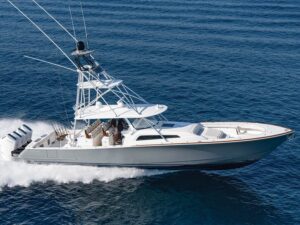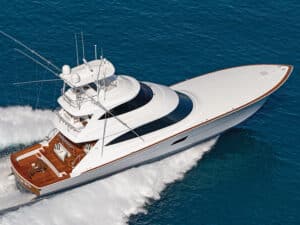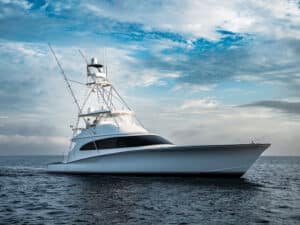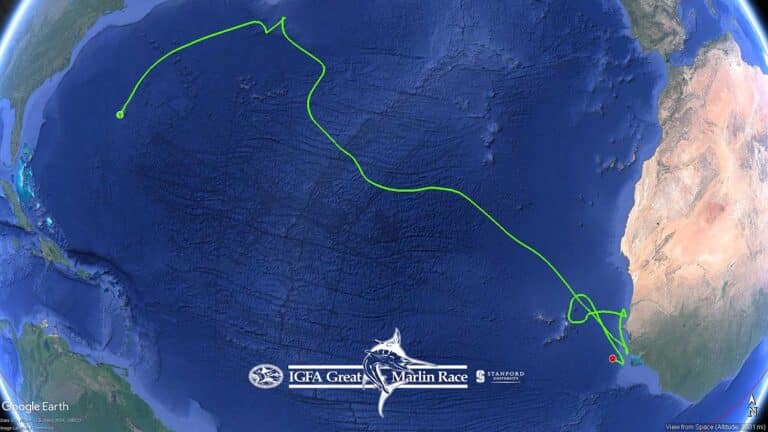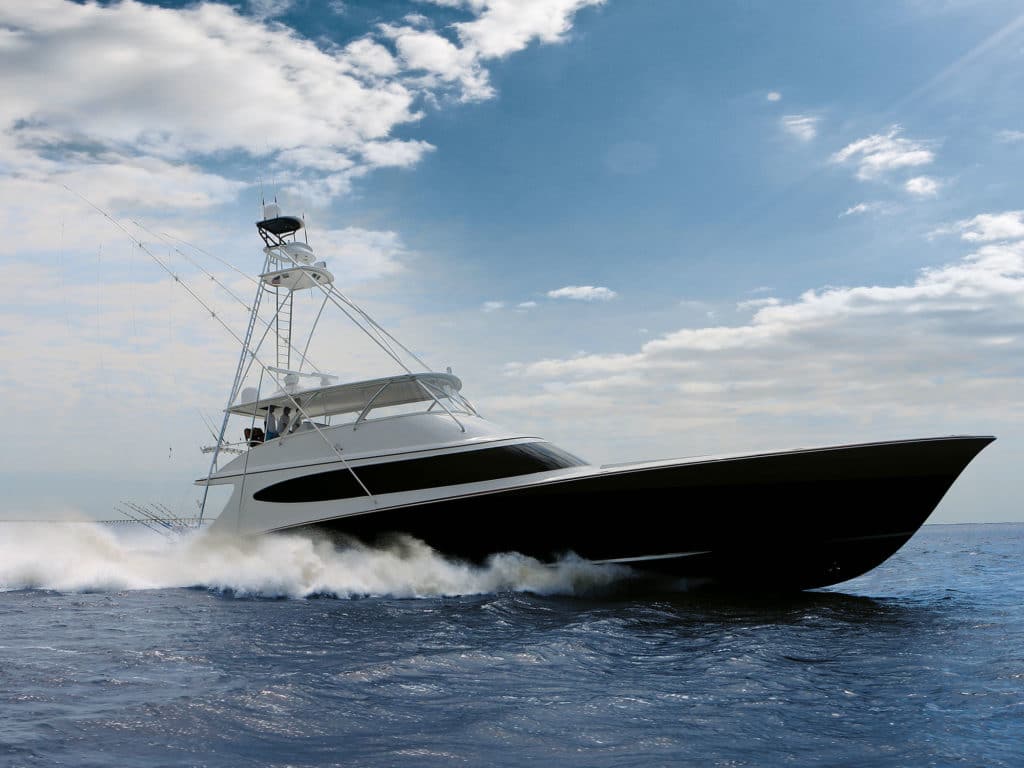
There simply aren’t enough superlatives in the dictionary to adequately describe the latest build from Bayliss Boatworks. It’s a vision brought to life by a small army of designers, engineers, technical specialists and a boatbuilder with a can-do spirit and tireless work ethic.
“This project pushed our entire team into a realm somewhere between a mega-yacht and a sport-fishing boat,” comments John Bayliss. The build began in 2013 and took more than 95,988 man-hours and about 40 months to complete, finishing just in time to fish this year’s Big Rock Tournament.
“The hull is similar to our most recent 80- and 84-footers,” Bayliss says. “The 90 is just longer and wider to carry the additional weight of the hull and its contents. At over 180,000 pounds, it is surprisingly fast and very responsive to the helm.”
Appearance
The 90-foot Singularis is breathtaking, with its flag-blue hull and gleaming-white house and foredeck. The lines are graceful, and the attention to detail can be seen everywhere you look. One of the first things that caught my eye was the raised longitudinal accent blended into the side of the hull that extends from short of the bow aft and wraps around the hull window for the master stateroom.
Hull windows can be tasteful, bland or tasteless, but this approach was above and beyond, playing off the sheer line, teak toe rail, engine vents and stainless rub rail inserts. The use of teak, often quite intricate, is extensive inside and out. The overall appearance of the boat is a balancing act of gentle shapes and radius corners, with blends of brightwork and painted surfaces that give it great appeal.
Engine and Pump Rooms
Access to the power plant and major systems of Singularis is attained from the cockpit by raising the center of the lower-mezzanine couch and heading down a short ladder to a watertight door. The sight tubes for the fuel tanks and storage for couch cushions are located there; the Seakeeper 35 is just aft. Through the door is a world of pristine white, chrome and polished stainless steel that includes the pair of massive MTU M94 diesels and two Northern Lights 38 kW generators with custom operation panels to quickly check oil and water levels.
On the portside outboard of the engine is a bank of batteries and breaker panels. Bayliss prefers traditional breakers to digital control systems, especially on boats that will be out of the country with any regularity. The engine room is monitored by cameras tied into the helm electronics and A/V system on board. A pair of IceSea ice makers also reside beneath the cockpit aft of the engine room.
The pump room located forward includes two FCI watermakers that can produce a combined 3,600 gallons per day; the 16-zone Cruisair chiller system is also located there. Two sea chests feed the main engines and a pair of Scot pumps that supply the raw-water washdown and other systems. The retractable transducer for the Furuno 360-degree-scanning sonar is also housed here within its own sea chest. There is a compressor system that can refill up to eight scuba tanks simultaneously, a hanging closet for wetsuits and dive gear, and a system for blending Nitrox.
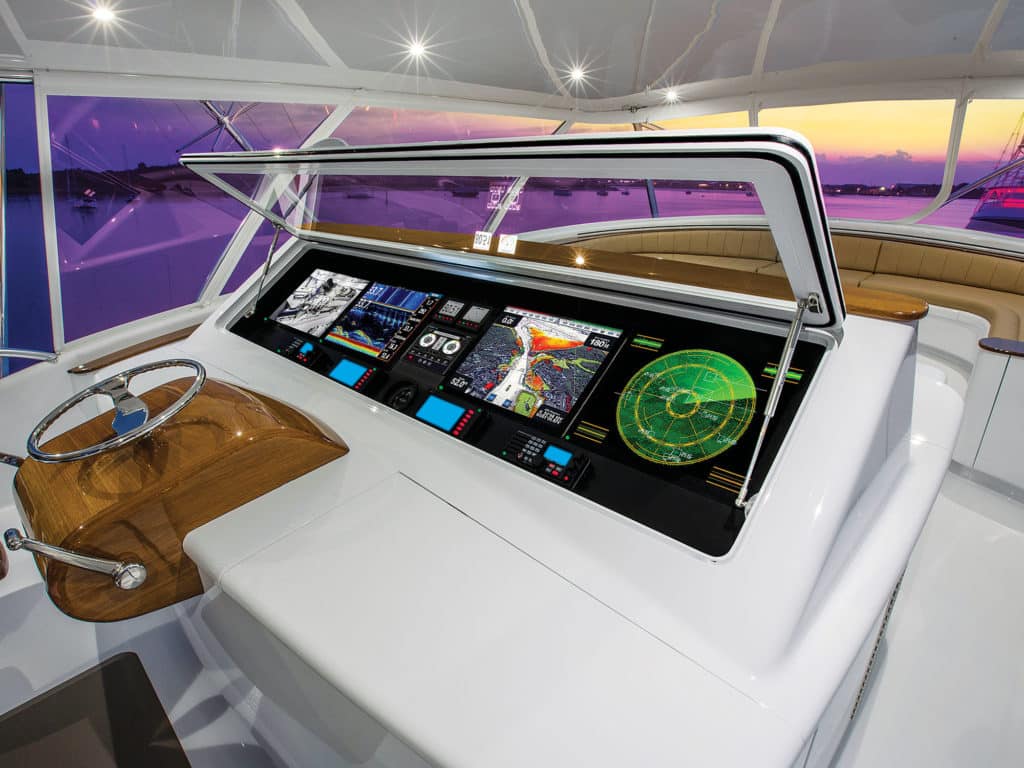
Cockpit
The cockpit is one of the star attractions for any Bayliss, and this one is a tour de force with a number of unique features. Sitting on one of the couches of the dual-level mezzanine looking aft is akin to being in an amphitheater, and the fishing space is immense. Center stage is a stainless-steel plate that accepts four different configurations depending on target species or activity. When chasing big fish, there is an offset stanchion for a Release Marine fighting chair. When trolling for whites or sails on light tackle, a large rocket launcher and a straight stanchion can be used instead. The stanchion base is also plumbed to feed a pair of removable above-deck livewells for kite-fishing with live bait. When not fishing, a beautiful teak- and burl-inlaid table with folding teak chairs can be used for an elegant outdoor-dining experience. There is a convertible livewell/fish box centered in the transom, but for serious fishing days, there is a massive stainless-steel-lined fish box that is ice-fed and refrigerated.
The dual-level mezzanine is a step above cockpit level and includes seating for three anglers in addition to an upper spectator’s settee that stretches across the back of the salon bulkhead. Under the lower-mezzanine deck are hatches that reveal a set of pop-up cockpit controls, a grill, gear storage, plus drink and bait boxes. Under the upper settee are two large freezers, tackle storage and another refrigerated drink box. An aft-facing 32-inch LCD screen drops out of the flybridge overhang that can be used for entertainment or to monitor bridge electronics. A pair of hatches in the cockpit aft corners serve as dive-tank storage and are plumbed with hoses to refill the tanks in place.

Interior
Upon entering the salon, you will immediately recognize the interior treatment of Singularis is different from the more traditional appearance of other yachts. The use of teak is extensive, with much of the wall panels and cabinets done in dark umber stain with accents and tops utilizing some of the most unusually grained teak boards I’ve ever seen. The overall appearance is modern and minimalistic while still exuding a rich aura.
An extra-large U-shaped couch sits against the aft bulkhead on the port side and is wrapped around a beautiful teak- and ash-burl coffee table. A pair of wraparound cushion chairs fit into matched notches in a light teak countertop to starboard. Four sets of doors hide a well-stocked wine chiller, liquor cabinet and crystal storage. Every cabinet and drawer on board has an intended purpose, and whatever goes into it fits perfectly into padded nests. The result is a dead-quiet boat while running, with no rattling or clinking — just the hum of the engines and the rumble of the exhaust note.Forward to port is a large dinette table that matches the coffee table with a wraparound bench large enough to seat six. Opposite, the galley is ringed by beautiful leather-finished granite countertops as well as a four-burner induction range with a Miele Speed Oven below, a Viking microwave/convection oven above and a Miele quick-cycle dishwasher off to the side. Food storage is in six Subzero drawers. Entering the companionway and just before the stairs is a day-head and laundry to port. An entrance on the starboard-side is for a room housing the breaker panels and system monitors, A/V components and A/C units.
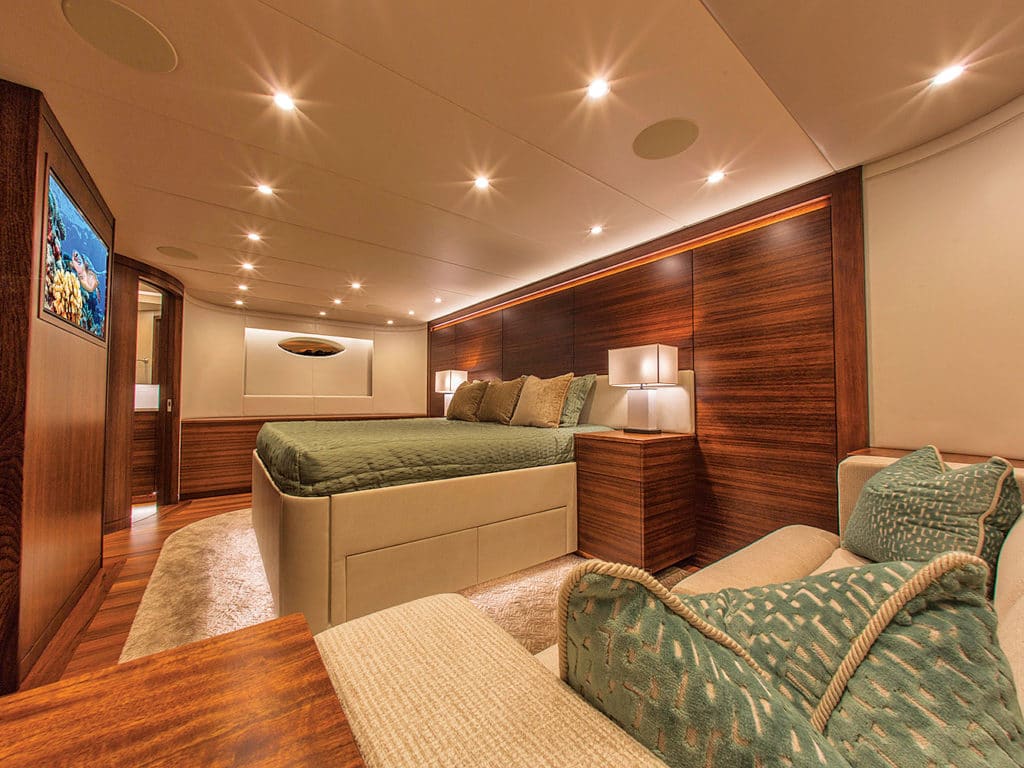
Sleeping Accommodations
A long companionway below accesses the four staterooms forward, two VIP staterooms amidships and two double-bunk crew quarters in the bow. All have private heads finished in marble and teak. The full-beam master stateroom is aft and accessed by going down three steps where it resides beneath the salon, forward of the pump room. The suite features a king-size bed, walk-in closet, and a plush head finished in imported Italian tiles and marble. Large, vertically grained teak panels behind the bed adorn the bulkhead wall, with accent grooves running the full circumference of the room. Windows with power privacy shades allow for natural light.
Bridge
Three custom Release helm chairs are situated behind a 12-foot-wide center console with a glass helm. Four 21-inch KEP monitors allow you to view the Garmin chart plotter and radar, the Simrad chart plotter and radar, and the 360-degree-scanning Furuno CH-250 sonar system in any combination you desire. An aft-facing couch rings the forward portion of the bridge around another teak- and ash-burl table. This beautiful table is the largest on board and hides two freezers underneath.
Four Miya Epoch computerized dredge and teaser reels are in the overhead compartment and are routed to the hydraulic 50-foot, five-spreader Rupp outriggers. The flawless pipe work extends upward to the tower, easily 45 feet above the waterline.
Performance
She might be big, but the Singularis can cook when you pour on the ponies. With an approaching tropical storm and Oregon Inlet its usual hinky self, it was decided to run her in the Sound, where there was a 1- to 3-foot short chop that was never felt. The boat has a smooth, solid feel at speed; between Bayliss and her captain, Jerry Lanzerotti, I got a good idea of what she can do. Flat-out, the boat hit 38 knots, which is fast for any yacht, but it’s almost ridiculously fast at 90 feet. At 30 knots, the sheer size of the boat masks the feeling of speed, but she can cruise all day at 75 percent load burning 160 gph. Drop it down to 25 knots and consumption dips to 126 gph; back off a little more to 22 knots and she sips 92 gph. So she can run with the fast crowd, but can a sport-fisher this big dance with billfish? She sure can, and Bayliss wouldn’t have it any other way. Her moves were surprisingly nimble as Lanzerotti had her backing down at 9 knots, making maneuvers to port and back to starboard as if in pursuit.
On the troll, the water behind the boat is almost undisturbed. “There is almost no white water, which means a better view of fish moving into the pattern,” Bayliss notes. It isn’t often that I get to experience a vessel the size and caliber of Singularis, and I was honored to have Bayliss with me the entire day we spent aboard. He is duly proud of all the work his team put into making it possible — and with good reason. She is a very special vessel.
Specs
- LOA: 90’1.5″
- Beam: 22’11”
- Draft: 5’10”
- Disp.: 180,000 lb.
- Fuel: 4,000 gal.
- Water: 500 gal.
- Power: Twin 2,600 hp MTU M94 Series 2000 diesels
For more coverage, visit the Bayliss 90 Performance Review page.
To see more boats from Bayliss Boatworks, visit 90-foot Singularis, Bayliss 64-Foot Parranda and Bayliss 64-Foot Lor-a-Di boat build galleries.
